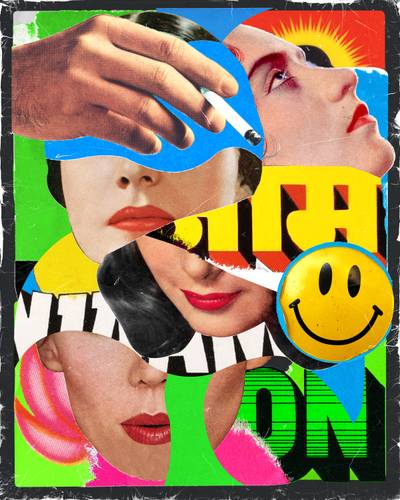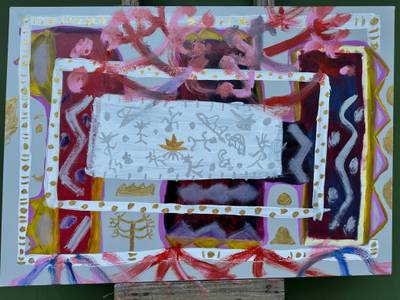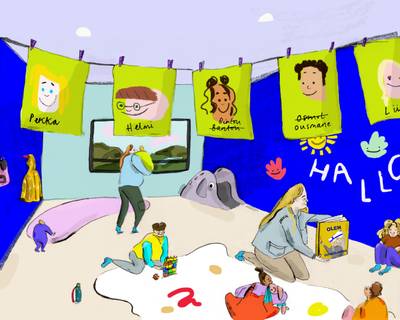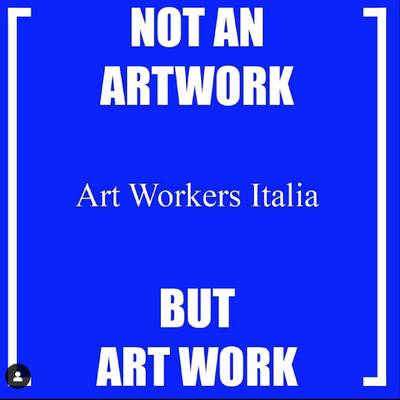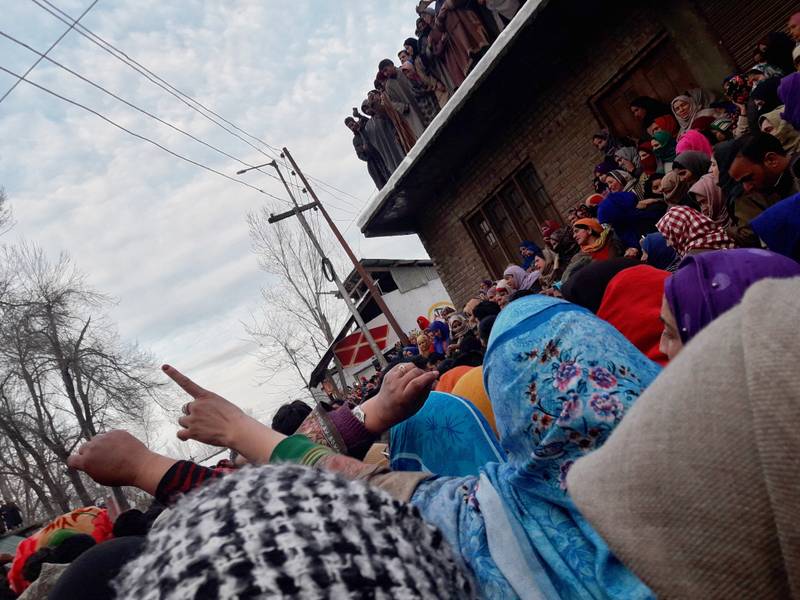

Photo by Shefali Rafiq, from the project “Women at Funerals,” which aims to show the participation of women in the funerals of martyrs. In this picture, taken at the funeral of Parvaiz Bashir Bhat, a 17-year-old boy from the Qaimoh area of Kulgam district, women are seen raising slogans upon seeing the body of Parvaiz. Parvaiz joined militancy on June 28, 2018. He attained martyrdom at Kelam village of Kulgam district on February 10, 2019.
Shivangi Mariam Raj is a writer, translator, and independent researcher based between Paris and Delhi. She works with The Funambulist, a platform that examines the politics of space and bodies.
It was during those five nights in February 2020 that I saw smoke and ash condense into a heavy moon over the rooftops of Mustafabad, Chand Bagh, and Noor-e-Ilahi. Wispy bridges stretched in a crisscross over drains where young men were being fished out, being separated from garbage for their families to perform their last rites. Screams yellowed in the streets, and we were counting the dead—our numbers were to be dismissed as “unofficial figures.” It was a pogrom. Muslims of this neighbourhood in North-East Delhi were under attack by their own neighbours and Hindu mobs that swarmed through the carcass of hours. Soot. Everything was charred, deformed beyond recognition, and nightmares clasped our eyes, afraid to seep out.
Inside the home I had taken shelter in, the calendar moved to March, and the children woke up early to knocks on the door. The cameras had arrived.
In India, as anti-Muslim violence continues to escalate with each passing day, the names of our dead are fast blurring into oblivion, each image of a bulldozed home fusing into another. The deliberate simultaneity of attacking Muslim space and body constitutes an active, ongoing process of ruination, where debris is sought both as a material and an affective consequence.
Intensified by infrastructures of caste and capital, this ruination is not new, even as the last few years have placed it into wider circulation through a compulsive carousel of photographs. Ruination is the foundational violence that established the Indian nation-state. Long perfected in Indian-Occupied Kashmir over the last seven decades, camouflaged under the optics of democracy and development, it is ruination that has accelerated India’s settler-colonial project, setting the layout of demographic engineering across the region. For the minoritised body in India and the occupied body in Kashmir, ruination shifts registers in its methods, intensity, impact, and opacity for the state to differentially reactivate and reaffirm its mythologies.
By routinely framing the Muslim body in a disfigured state, the atrocity image acts as an instruction manual to designate its aukaat (spatial and temporal coordinates of one’s position in society) in the ruling caste order. These photographs become coercive networks that normalise such subjugation and determine the mechanics of perception production in a way that keeps the relationships of violence they exhibit intact. With each image, the community is robbed of the familiarity of streets, the sanctity of mosques, and the intimacy of home, and this body—consolidated in its corporeal, psychological, spatial, spiritual, and social arrangements—is torn apart over and over again. A weapon that extracts the body from itself and controls it by rupturing all its senses of belonging, by forcing it to view itself amidst ruination.
The Impossibility of Speech
Codified as evidence, we have tens of thousands of photographs that serve as documents of blood, calls for justice, demands for recognition, and appeals to conscience. Evidence constellated outside the community. Seldom do these atrocity images act as a resource within the community to generate conversations on the violence they record. They produce the body and the knowledge of this body for the gaze of outsiders, to whom this violence must always be translated and rendered legible. In the hope of some elusive justice or some chance goodwill gesture from the same forces that commit these crimes, these photographs make the community vulnerable to this intrusive gaze, whether in ridicule or sy/empathy. They displace the community from its own grief and the image of its own body. By repeatedly reproducing the minoritised/occupied body in its death and destruction, by creating violence as the only aesthetic that carries this body in public, they distort and defer mourning.
For those who are written off as perpetual “savages” in the catalogues of civilisation, who are exiled from history, and who are shoved to the bottom of the hierarchy of humanity, who are these photographs of their subjugation addressed to?
The same conditions that create violence, both in its spectacular and mundane routines, also create the obligation for the survivor to constantly relay her suffering, to speak without the pause necessary to be heard. These images then commit another violence—this violence after the violence—one where the survivor is forced to participate against herself. She must stand in the service of history and its historians and their archives, only to be misplaced, misidentified, and misrepresented by them. She must yield to a history that holds no space for the immensity and irregularity of her memory. These images insist on acting as mediators, offering an interpretation of the event and arguing for certain ideological positions. But Armenian writer Marc Nichanian alerts us to the will to annihilation that far exceeds these attempts at explanation. In sharing these images, we busy ourselves justifying that a neighbourhood was indeed demolished, that a massacre unfolded indeed—we hereby lock the survivor into proving her own death—but we have nothing to show for or document this will to annihilation. This will that forges the before and the after, this will that is shared equally between her neighbour and the police, this will that cannot be distilled into a photograph and hence remains unseen, free to choreograph another ruination. Photographs of pain interrupt and delay mourning by arresting the survivor in the relentless pursuit of proof.
For those who are written off as perpetual “savages” in the catalogues of civilisation, who are exiled from history, and who are shoved to the bottom of the hierarchy of humanity, who are these photographs of their subjugation addressed to? Surely, these cannot be for the dispossessed who already know their pain, who struggle against their oppressors, and who need not look at themselves ravaged to reinforce and reenact this violence. If the goal of these images is to bring awareness, why is death a precondition for Muslims in India and Kashmir for their political rights to be recognised?
When 65-year-old Bashir Ahmad Khan was killed on his way from Sopar to Kupwoar in Indian-Occupied Kashmir in July 2020, his three-year-old grandson was placed on his corpse for a photograph. Other photographs showed the child being “consoled” and “rescued” by the occupying forces. Although their origins remain unknown, these photographs went viral and were utilised by the Jammu and Kashmir Police and the Central Reserve Police Force to corroborate their account of Khan’s killing. By reposting these photographs, we participated in trampling upon his dignity. We were caught in replicating the logics of ruination. While the perpetrators claimed his life, these photographs laid claim to his death. Those who kill, those who demand evidence of this killing, and those who insist on looking at the killed all participate in owning the oppressed body. Occupation.
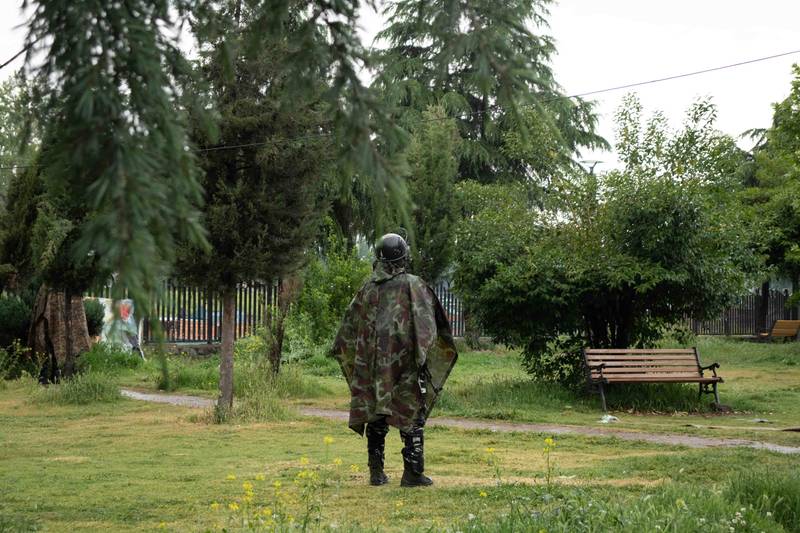

Photo by Zainab, from the series “365 Days of War.” Kashmir remains the most densely militarised zone in the world, with the Indian armed forces expanding their occupation apparatus to steal the authority that Kashmiris have over their land.
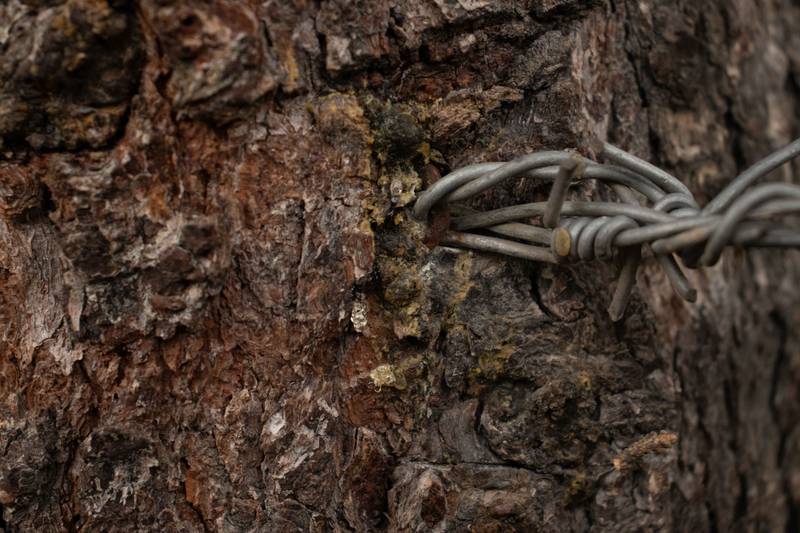

Photo by Zainab, from the series “365 Days of War.” Kashmir remains the most densely militarised zone in the world, with the Indian armed forces expanding their occupation apparatus to steal the authority that Kashmiris have over their land.
The argument that these images speak out against violence and represent the truth of the event is often used to justify their reproduction and circulation. While some photographs do serve a strategic function against state-sponsored propaganda and manipulated media by brahmin supremacist groups, they cannot be read as authentic or authoritative accounts of ruination. In their eagerness to illustrate ruination as an aberrational event, atrocity images fail to grasp the unspeakable. Their speech is not how the survivor practices language. They exacerbate this violence by claiming to represent it, only to eventually codify it within positivist and humanist frameworks. They construct ways of seeing that willfully overlook a series of slow violences that trace ruination into quotidian rhythms.
The atrocity image claims to be the “complete picture”: sequentially arranged, its smooth surface cradling a smooth narrative. However, the survivor’s narration is fragmented, bruised with tears, shrieks, grunts, sighs, stutters, and wails, struggling with memory, which is vivid, yet not complete, not regular. These shards of speech, this inability to draw the “complete picture,” these hesitations, these frustrations are the kernel of ruination, its consequence and its objective.
In April 2022, when the local authorities sent their bulldozers to devour the narrow streets of Jahangirpuri in Delhi, I was speaking with Asma Begum, whose tin-roofed shanty had been torn down. Her testimony was broken, the interstices between her words misted. I had seen all the photographs being rapidly disseminated across social media. But it is in her impossibility of speech that I could discern the weight of the crimes that transpired over those days. Photographs, despite their fullness, failed to capture this kernel. The legible language of these images is their conceit. This claim to speech is their denial of ruination practiced in language.
Such a practice of splintered language also breaks the sensory dominance of the event by moving across temporal registers. However, photographs flooding newspapers and social media streams cement the grip of the perpetrators by their chilling flatness, calculating ruination into a linear, immutable time. This brokenness allows the possibilities of mourning to trickle through the cracks—this fugitive image that the survivor carries in her eyes and her nightmares—this image against the image of the camera.
The Unimageable Against Imagination
Across Srinagar, Islamabad, Budgoam, Varmul, and Pulwoam, more than a hundred Kashmiri homes have been destroyed or burned down during military operations by the occupying forces over the last four years. Whenever photographs of their ruins or their grieving inhabitants were shared, phrases such as “I cannot imagine” or “Imagine if this was your home” would buzz across social media. These ostensibly good-intentioned utterances signal that, through imagination, the viewer is trying to identify with the subject in the image. It is crucial here to recall Saidiya Hartman, who wrote, “It is as though in order to come to any recognition of common humanity, the other must be assimilated… utterly displaced and effaced.” This is the logic in which the dominant visual field is organised: these photographs are shared not so much to document the pain of others, but rather to facilitate the imagination of the one who gazes, for him to sy/empathise and imagine himself in that position, in that scene of ruination, (super)imposing his own self over the survivor to understand the horror that unfolds against her. Such moral economy is predicated upon enforcing this “sacrifice” upon the minoritised/occupied body for the spectator to finally understand the processes of ruination that oppress her.
By translating this agony into pleasure for the viewer, these images use the body against its own self. A community is reduced to a set of trigger warnings—this violence of making everything seen.
The ease with which these photographs are shared by the viewers further hardens their idiom of power by freezing this pain as a collective cultural artefact. The survivor’s agony is thus rendered banal, and the viewers are desensitised over periods of repeated exposure, thereby nullifying any justifications in favour of such a circulation in the first place. In the public unconscious, this loss does not remain unique anymore and is added to a long grid of names and faces that flit down our screens. Some of these images become stock templates to explain other losses, to be mistaken for and interchangeable with other losses.
These photographs conscript minoritised/occupied bodies in the service of optimistic universalism of brahmin sentiments, where their false sense of intimacy exploits and appropriates the pain of the subject by deploying the camera as an interlocutor to codify the untranslatable into image. By translating this agony into pleasure for the viewer, these images use the body against its own self. A community is reduced to a set of trigger warnings—this violence of making everything seen.
This crisis of imagination and representation is accompanied by a crisis of perception: these images compose and instruct the viewer’s gaze by reconstructing the suffering body into a fetish object. This not only helps in absorbing the shock that comes from viewing these terrifying visuals but also signals to the viewer a perverse sense of control over his own safety, a reassurance of his conditions here that are not the same as those of the wretched others there. He is also granted an opportunity to perform the theatre of his own triumphant humanism. What passes for witnessing is consumption, where the spectator accumulates visuals that assist him in his performance of care and sy/empthy, where the focus shifts from the suffering body to the courage of the viewer who can endure looking at its agony. Voyeurism becomes a placeholder for committed political action. This is the aesthetic substrate of such unabated image production. The dangerous implication is that unless a community is able to perform its victimhood and unless there is an instrument that records (record as an archive, record as a camera), its political demands will not be considered legitimate. The minoritised/occupied body must speak to and speak in the language of its perpetrators. The sovereignty of the body is thus relinquished to its image. In a flash!
What does it do to our temporalities when ethnic cleansing, mob lynching, massacres, and settler terrors all unfold on our social media streams in real-time? Bloodied faces, mangled limbs, screams, bulldozed homes, loss of life, stolen dignity, futures robbed of their possibilities—in pixels, in HD, with filters. What memory of the body does it produce, an entire map of dispossession that can be scrolled up and down, pinched to zoom in and out? These tools that we rely on to look at violence impact how we understand it. This speed and convenience confirm Walter Benjamin’s observation that changes in the mode of human existence are accompanied by changes in the mode of human sense perception. The viewer is both the consumer and the owner of the image, he can modify it, choose how to view it, and make it yield what he wills. For him to completely own the image, he must hide his eyes from what he sees—seeing without seeing, facilitated by scrolling, by being able to afford a temporality so different from those who are contained in these images. The violence inside the image joins the violence that produces and disseminates this image. Such viewership is also how the majoritarian/settler body constructs itself.
The liberal fantasies that insist on the significance of these photographs for justice, awareness, representation, and documentation are cut short in their naïveté when the atrocity image makes its way into the Hindu right-wing digital ecosystems, further degrading the survivor by humiliating her in viral WhatsApp forwards, propaganda pamphlets, and memes. They repurpose the pain to generate affects of revenge, recreation, and gratification, affects that bind those who commit these crimes to those who watch. It is further compounded by another set of images, shared in an equally uncritical manner over social media, where the perpetrators film themselves and record their acts as a badge of honour, as a symbol of conquest. In February 2023, Junaid Khan and his nephew Nasir Khan were kidnapped, tortured, and burnt alive in a car near Loharu in Haryana. A month earlier, three Muslim men were abducted and beaten up on suspicion of being “cow smugglers,” and one of the men, Waris Khan, succumbed to his injuries. Both these acts were carried out by Monu Manesar, a prominent member of Hindu far-right organisation the Bajrang Dal, who livestreamed this violence to lakhs of followers across Facebook, Instagram, and YouTube. In fact, his popularity even earned him a Silver Play Button from the latter. Dedicated to cow vigilantism, his images capture Muslim men in scenes of degradation, ranging from their clothes torn apart to being force-fed animal faeces—and these images are monetised for revenue generation. It is the atrocity image that has allowed him to garner mass admiration and support from police officers, local ministers, and bureaucrats, and that aids him in organising more mobs across Rajasthan and Haryana.
With private giants such as TikTok and Meta deciding how and how much we can look, images turn into information displaced from their context to synthesise the unceasing stream of hate, attention, and capital. Yazan Khalili and Ariel Goldberg emphasise that in such a landscape, even photographers and photojournalists cannot protect their photographs from the “world disobeying the intention of the image,” as is evidenced by the photographs of the 2016 uprising in Kashmir being used by the Indian surveillance machinery to identify and arrest several protesters.
Our excessive dependence on this visual regime obscures months of anxiety that forced Hitmat Ali to commit suicide in Barpeta, trying to prove that his wife is not an “illegal migrant” in India; the exhaustion that Parveena Ahanger has been experiencing every day since the last three decades as she tries to search for her son subjected to enforced disappearance in Indian-Occupied Kashmir; the dailiness of Indian legal infrastructures, these weapons without the spectacle of blood; the malice that local Resident Welfare Associations practice against Muslim residents, hawkers, and small businesses in Uttarakhand. This violence that cannot be captured in an image.
Carceral Imaginary of Appeal
A large number of photographs concerning colonial violence in Kashmir depict Kashmiri women in states of distress, aching and crying. Their subsequent reproduction as thumbnails, posters, and cover images further diminishes the contribution of Kashmiri women to the resistance in these lumps of emotional vulnerability. Kashmiri researcher Sadaf Wani asks, “How many Kashmiri women have had the opportunity to play a part in constructing these resources and contribute to shaping perceptions around their identity?" Naseema Akhtar of Qaimoh, Kulgoam, made one such attempt when she posed with her son, Shaheed Tauseef Ahmad Sheikh, and a gun. In June 2020, she was arrested under India’s Unlawful Activities (Prevention) Act. The defiance of her photograph refused to appeal to the “collective conscience” of the colonisers. And this is why she was punished.
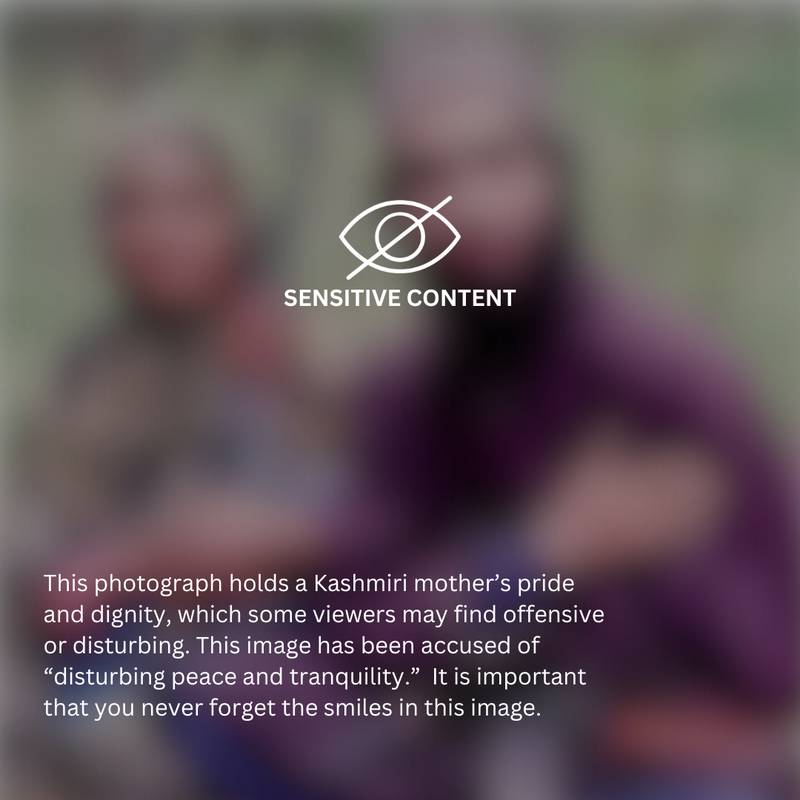

From the series “Viewer Discretion,” 2019–ongoing, Shivangi Mariam Raj.
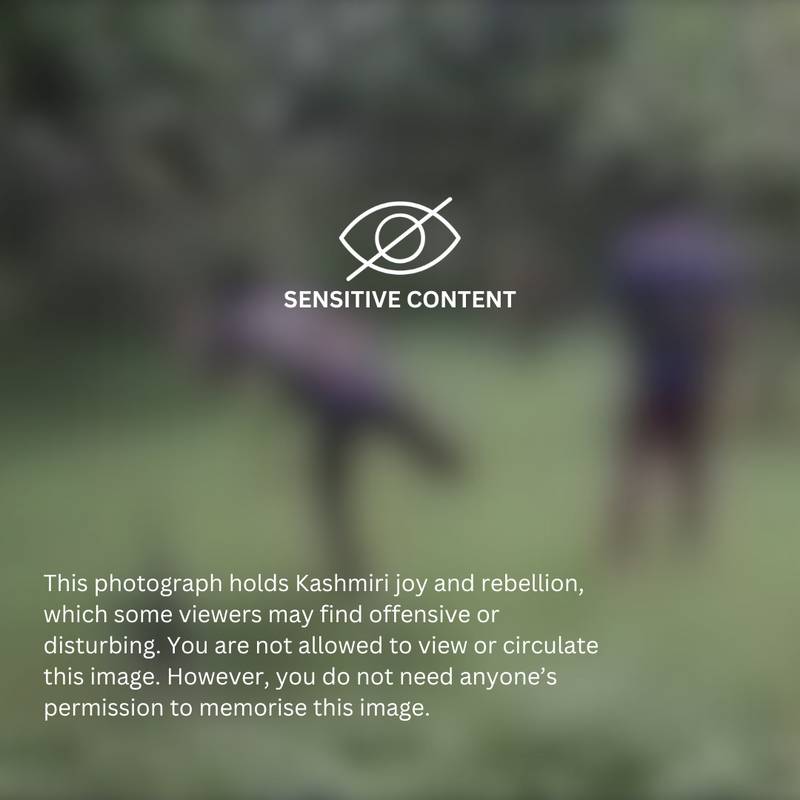

From the series “Viewer Discretion,” 2019–ongoing, Shivangi Mariam Raj.
Everything that these photographs of pain claim to achieve is premised on their affective production of authentic victimhood, of the subject who is pure in her suffering, suffocatingly noble, and morally superior to those who cannot meet this criterion. The Muslim body in India is only “good” when it is secular; the Muslim body in Kashmir is only “good” when it obeys the assimilationist project of the occupation. Their rights can be legally recognised, and they can be socially accepted only when they are rinsed of their political identities when their psycho-spiritual conquest has rendered them “neutralised.” It is through these images of a “good” Muslim that a simultaneous image of a “bad” Muslim is established. This “bad” subject who is not palatable to rights groups, journalists, and activist collectives, who is dangerous and unworthy of both justice and grieving. Perhaps this may explain the unnerving silence around Shahrukh Pathan’s incarceration over the years because the only photograph of his that was placed in mass circulation froze him in the impossibility to claim innocence. Which photographs galvanise the public into action and which photographs never make it to Twitter trends or Instagram hashtags are all determined by the aesthetics that reaffirm and uphold the safety of the majoritarian status quo.
The depoliticised aesthetic of suffering that frames these appeals seeks to isolate and individualise ruination rather than exposing its pervasive structural continuities. In producing the innocence of the subject, they also produce her as incapable of being a threat. The compliant subject, dominated and domesticated by the gun and the camera alike. Photographs of suffering are rearranged into photographs of appeal, instructing us to seek succour from the very institutions designed to sustain the violence against the minoritised/occupied body, which is always suspicious, always guilty, always expendable, which must always prove its innocence to prove its humanity. These photographs construct the spatiality of Fanon’s “zone of non-being,” where the minoritised/occupied body is not human, sans histoire, without a story, without a history.
Kashmiri rebel commander Burhan Wani created an alternative counter-aesthetic to challenge the occupation’s dominant visual regime. Against photographs of martyred rebels dismembered and mutilated beyond recognition, against photographs that portrayed them as “savages” banished from their humanity, their story, and their history, he unfurled photographs of life, of belonging to his homeland, of unrestrained joy that is liberated from all clamours for appeal.
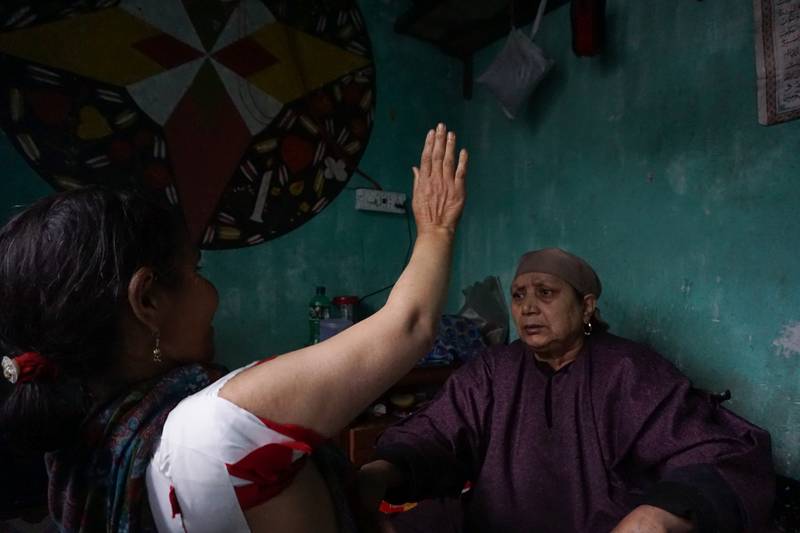

Faat Aapa, 65, a traditional bone-setter treating her patient in Gassipora village of south Kashmir’s Anantnag district. Working in a small and moderately lit room, Faat Aapa has treated thousands of patients for the past three decades.
The Politics of Domination by Spectacle
In April 2017, a viral clip documented Farooq Ahmad Dar of Chil village, Budgoam, being strapped to the bonnet of an Indian army jeep as it led a convoy through the district in Indian-Occupied Kashmir. He was beaten up, tied to the jeep as a human shield and driven through at least 28 villages for more than five hours. A month later, the Indian army major responsible for this act, Leetul Gogoi, was awarded the Chief of Army Staff’s Commendation Card, and a year later, this image was printed on a T-shirt and sold in India for INR 495. It was also popularised as a meme and an advertisement campaign. Despite its heavy circulation, because of its heavy circulation, this spectacle served the purpose of reinforcing the settler-colonial order in Kashmir and compounded Farooq’s trauma with each reiteration of the image.
The term “spectacle” becomes quite revealing as the same forces that rehearse and stage these horrors now become its viewer-voyeurs. Grander the spectacle, the more humiliating and lasting the suffering. Photographs translate the act of violence into aesthetics, with the claim that witnessing these will translate into justice. We all saw the photographs of Babri Masjid being demolished on December 6, 1992. A live telecast rushed through some networks, carrying the proud smiles of thousands of Hindu volunteers who participated in its destruction. Once again, on June 12, 2022, this spectacle reappeared when Afreen Fatima’s home was razed to the ground in Allahabad, and its destruction was broadcast live, cheered on by journalists on the site and in bulldozer-themed studios. Neither received any justice. The spectacle of Muslim men paraded with raised hands through the streets of Hashimpura, Uttar Pradesh, in 1987 was echoed in the spectacle of Muslim men paraded with raised hands outside Jamia Millia Islamia, Delhi, in 2019. This is how the minoritised/occupied body is obliterated in and by its own image. This is how we are conditioned into the seduction of photographic “truth.”
These atrocity images are no different from lynching postcards of the 19th- and 20th-century United States, where white supremacists would inscribe these images with anti-Black texts for distribution as souvenirs. Now, the minoritised/occupied body is entombed in our digital devices.
Concealing power within their aesthetics, such spectacles reinforce segregation, serve as a warning against any transgression of the brahminical order, and flaunt a continuum of impunity granted to the perpetrators. Their domination is protracted by their claims to virtue in administering “mob justice” and “bulldozer justice,” strains of retributive justice popularised over the last few years. In most instances of violence, Indian courtrooms set the perpetrators free; some were “found not guilty,” others were out on bail, some organised even bigger hate rallies, and others were rewarded with an electoral party ticket or with gallantry awards from the Indian armed forces. In each case, the judges cited “lack of evidence”—despite the atrocity image gliding into a superfluous sequence of evidence on our screens—and social media trends moved on to the next hashtag. Justice participated in the crime. This impossibility of justice within the present codes of permanent security of the nation-state—and not appeals to justice—is the image of ruination. This infernal apparition that evades the photographic form.
What could be forms of image-making that inhabit stillness with the community as it mourns this ruination instead of museumising its suffering? Images that hold a scene—and not shoot. Can there be images of the broken, burning memory of the survivor? How to fight brahmin supremacist violence in India and demand Kashmir’s liberation without disseminating images that spectacularise their ruination? Can we prioritise sensation over sensationalism? Do we have the collective tools to respect the rights of those who wish to remain unseen in life and in death, who do not want themselves to be reduced to a body circulating in pixel streams, their fate decided by algorithms? This endless looking without reflection is what Byung-Chul Han categorises as pornography, this unmediated contact between the image and the eye. What measure of accountability can we honour to establish an ethic of seeing? How to build solidarities that are not conditional on these appeals of innocence?
In July 2016, during the uprising in Kashmir, as the Indian occupying forces launched heavy pellet firing against tens of thousands of protesters, as hospitals were teargassed, as ambulances were fired upon, I saw kitchens turn into makeshift clinics to treat the wounded. In this Islamabad neighbourhood, pliers and knives were heated on stoves and candles, we held tongs as surgical instruments. The sky was pierced with stars and raindrops, and young men continued to bring in the injured delicately balanced on their backs. Slivers of glass and whispers enveloped us. The world devoured the photographs of these pellet-ridden lives—and did nothing. Defying all gaze, absent from all photographs, these kitchen clinics persisted in their subterraneous gesture, reciting the unspeakable to our eyes.
